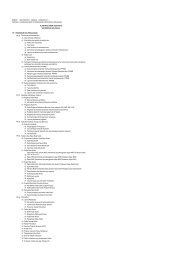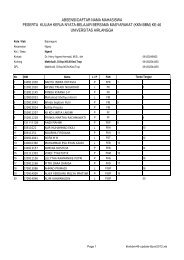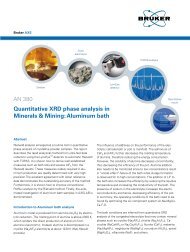Scanning Electron Microscopy - UNAIR | E-Book Collection
Scanning Electron Microscopy - UNAIR | E-Book Collection
Scanning Electron Microscopy - UNAIR | E-Book Collection
- No tags were found...
Create successful ePaper yourself
Turn your PDF publications into a flip-book with our unique Google optimized e-Paper software.
The incident electron beam creates a complex series of interactions with the sample(see discussion below), causing the emission of electrons and X rays from the sample.Detection of the electron emissions causes a voltage signal to be produced from adetector, which is then amplified. This amplified signal is applied to a pixel grid on theCRT and modulates the intensity of a spot on the CRT monitor. In this way, bright (dark)spots on the monitor appear every time a relatively large (small) number of electronemissions are detected from the sample. Surface peaks on the sample result in largeelectron emissions, while surface valleys yield reduced electron flux. Thus the SEMimage consists of thousands of lighted pixels of varying intensity on the CRT monitorthat correspond to the topography of the sample.Figure 4 indicates the various types of emissions from a sample that can be detectedfollowing the interactions that occur between the primary electron beam and the sample.Of these, secondary electrons form the primary means of the formation of an SEM image.Secondary electrons are produced mostly by inelastic collisions between the electrons ofthe primary beam and those in the weakly-bound conduction band of the sample. Byconvention, they are defined as electrons emitted from the sample with a kinetic energyless than 50 eV.Backscattered electrons result from the elastic scattering of beam electrons from theatomic nuclei of the sample. The energies of backscattered electrons range from 50 eV(using the same convention as that applied to the secondary electrons) up to the initialkinetic energy of the primary electrons in the incident beam, due to possible multiplescattering in the sample.When beam electrons induce ionization of an inner-shell electron in the atoms ofthe sample, X rays characteristic of the element can be released from the sample (andlater detected) when an electron from an upper shell fills the vacancy in the ionized shellwith an energy equal to the energy difference between the two discrete states (E γ = hν =E i – E f = ΔE). Alternatively, the X-ray energy may be transferred to another atomicelectron, which leaves the sample as an Auger electron with a kinetic energy determinedby ΔE minus the energy necessary to overcome the ionization energy and the bindingenergy (or work function) of the sample. Both Auger and secondary electrons are highlysusceptible to elastic and inelastic scattering and can leave the sample only from a verythin surface layer on the order of a few nanometers thick, thus making them a sensitiveprobe of the surface features of the sample. However, they can be generated bybackscattered electrons originating from a deeper region of the sample surface, inaddition to the narrow beam of primary electrons entering this thin surface layer.Other electron beam/sample interactions include electron-beam-induced surfacecurrent (EBIC) and cathodoluminescence (CL), both byproducts of inelastic scatteringwith the primary electron beam. EBIC results from the charges liberated from thecollisions, while CL refers to the emission of light resulting from electron transitionsacross energy band gaps in a sample.4
Figure 4. The primary interactions that take place between the incident electron beamand the sample in scanning electron microscopy.Experimental Apparatus and TechniquesThe OWU SEM apparatus is shown in Fig. 5, with the major components labeled.Interior views of the vacuum chamber are displayed in Figs. 6 and 7. The sampleplatform and vacuum thermocouple (for measurement of vacuum pressure) are shown inFig. 6. Most of the other hardware shown in the figure relate to the rotation andtranslation of the sample platform.Figure 7 shows the various detectors used in the SEM. The secondary electrondetector is of the Everhart-Thornley type (see S. L. Flegler et al.), consisting of a CaFscintillator with a surrounding Faraday cage used to both attract secondary electrons aswell as to shield the electrons from the high voltage applied to the scintillator itself.When in use, the backscattered electron detector is inserted concentric to the primaryelectron beam (hence the hole in the center of it). It has a relatively large surface area toassist in the collection of the rather high-energy backscattered electrons. The X-raydetector is a lithium-drifted silicon [Si(Li)] crystal detector. The detector is kept at liquidX-ray detector with liquidnitrogen dewar<strong>Electron</strong> gun andvacuum chamberSEM control and imageacquisition pcFigure 5. The OWU SEM and auxiliary components.Joystick control ofsample platform position5
nitrogen temperature in order to reduce leakage current (electronic noise in the crystalresulting from free charges), and to prevent redistribution of the lithium as well aspossible electrical breakdown in the crystal induced by the applied bias voltage due todecreased resistance at higher temperatures (true of all semiconductors in general).Vacuum thermocoupleSample platformFigure 6. Internal view of the SEM vacuum chamber, showing the sample platform.Primary electron beaminjectorX-ray detectorBackscattered electrondetectorSecondary electrondetectorFigure 7. Internal view of the SEM vacuum chamber, showing the various detectors usedand the tapered injector of the primary electron beam.6
Experimental ProcedureFamiliarize yourself with the operation of the SEM. Make sure you are trained onthe operation, control, and data acquisition techniques by the OWU <strong>Scanning</strong> <strong>Electron</strong>Microscopist.Collect magnified images and X-ray spectra for the known sample, the sample thatyou supplied, and the unknown sample supplied by your instructor. (Note thatconducting samples provide better images than non-conducting ones, since conductingsamples provide a path to ground for the incident electrons, reducing surface charging ofthe sample which would appear as extraneous bright spots on the image.) Be sure torecord all of the relevant SEM parameters for each image (magnification, beam current,and primary electron beam energy). Place a scale marker on each image you record togive a sense of its size. Record X-ray spectra using the electron beam energyrecommended by the <strong>Scanning</strong> <strong>Electron</strong> Microscopist, with the primary electron beamplaced in at least three different locations on each sample.When performing an X-ray analysis of a sample, it is important to select theelectron beam operating conditions that optimize accuracy and precision. For example,increasing the accelerating voltage will improve the X-ray count rate and peak-tobackgroundratio and therefore the precision and sensitivity, respectively. However,increasing the beam accelerating voltage will also increase the absorption of lowerenergyX-ray lines. A correct determination of the accelerating voltage and beam currentdepends on the elements under investigation and the spatial resolution required. Ideally,we would like to select X-ray lines which are similar in energy for each of the analyzedelements in order to obtain similar excitation volumes from each element. A good rule ofthumb for properly exciting X-ray transitions is to choose an electron beam energy that isabout a factor of two larger than the largest expected X-ray energy (“edge” energy) froma particular element. For example, the edge energy for nickel, 8.33 keV, determines theminimum acceptable beam energy of about 16 keV which will adequately excite Ni K αradiation. For more information on this topic and a thorough introductory discussion onthe methods of X-ray microanalysis in scanning electron microscopy, see S. L. Flegler etal.Procedure quick referenceAll of the SEM control functions can be selected from a menu of icons (or dropdownmenus) in a Windows-based program. The following is a list of the mostcommonly used functions:• Vacuum status windowo Use “Vent” button to vent vacuum chamber to air pressure (valves tovacuum pump system shut and dry air introduced to vacuum chamber)o Use “Pump” button to evacuate vacuum chamber of air. (“Good”vacuum obtained when chamber pressure ~ 7 × 10 –5 torr.)• To start/stop primary electron beam: click on traffic light icon7
• To alter brightness of image: click on sun/moon icon, then adjust by clicking anddragging with left mouse button• To change magnification/focus: click on magnifying glass icon, then adjust byclicking and dragging with the left mouse button• To change energy of primary electron beam: click on lightning bolt icon• To alter position of sample in monitor: use joystick control of sample platform• To perform X-ray analysis: run LinkISIS programo Set focus to 19 mmo Improve focus of sample on monitor using joystick “z” controlo <strong>Electron</strong> beam energy can be typed in directlyData Analysis and DiscussionPerform a qualitative study of the images produced by the three samples. Discussthe general surface features and any variations in the features that you see, including anypossible stresses, fractures, impurities, or other defects. When a non-conducting sampleis used, some images may appear particularly bright in spots, as if a flashlight wereshining on them. Explain why this happens in terms of the electrical properties of thesample material.Determine the total background-corrected counts of each clear peak in onerepresentative X-ray spectrum for each sample. This is the total number of countssubtended by a peak minus the number of (constant) background counts near the samepeak. What statistics should be used to calculate the random error associated with thismeasurement? Calculate the random statistical error for the total background-correctedcounts for each peak based on the answer to this question. Calculate a “peak-tobackground”ratio (ratio of net peak counts to background counts) for each peak in eachsample spectrum that you analyze. Note that the bigger this ratio, the better. Why?Perform an elemental analysis of all three samples that you observed with theSEM. Using your X-ray spectra, describe the elemental composition of each sample, anddetermine what the unknown sample is.In your discussion of the physics of the SEM, provide the answers (with details onhow you obtained the answers) to the following questions:(1) Assume that the electromagnetic lenses of the SEM have focusing propertiessimilar to that of thin glass lenses. If the three lenses of the electron opticssystem each have a focal length f and are separated by a distance L, what is theeffective focal length of the three-lens system?(2) A small electron spot of diameter d 0 at the sample is produced by successivedemagnification of the first crossover image (see Fig. 2) of diameter d c bymeans of the three-lens system. Provided that each intermediate crossoverimage is formed at a (relatively large) distance D in front of the next lens, thesubsequent demagnified image will be near the lens focus, at a distance(1 / f – 1 / D) –1 ≈ f, and the total demagnification of the system results in a8
spot with the geometric diameter d 0 given byf1f2f3d0= d c= md c, (1)L L L123where m
















